
The Authenticity of Keith Richards: Reading his autobiography Life against the grain
Keith Richards' Life is one of those books I keep returning to. Every year I read a few chapters and immerse myself in the authentic life of a rock 'n roll bohemian. I have always done this uncritically, taking Richards' words at face value. But how authentic is Keith Richards actually? What effect does his celebrity status have on the narrative he presents to his readers? And what is Richards trying to prove? Let's read Life against the grain.
Life: the indestructible Keith Richards
“There are two things that would survive a nuclear holocaust: cockroaches and Keith Richards.”
Source unknown
In 1973, music magazine New Musical Express compiled a list of rock ‘n roll stars that were most likely to die soon. Rolling Stones guitarist Keith Richards, aged thirty at the time, peaked the list for ten years and it was no surprise that he did. After all, throughout the 70’s and well into the 80’s, Richards was known by the public for his drug abuse and run-ins with the law. Now aged 74, and in spite of his drug-infused bohemian lifestyle, Keith Richards is still alive and kicking, and so are the Stones. Having just finished their tour across Europe while in the meantime picking up a Grammy for their blues cover-album Blue and Lonesome, Richards and the Stones are still doing what they have been doing their entire lives: rocking and rolling.
Yet the turbulent times in which the Stones garnered their rebellious image have long waned and so has the counter-cultural force behind it. In fact, the Rolling Stones are by now best known for their celebrity superstar status. Evading taxes, charging exorbitant prices for their concerts and piling up royalties have enabled them to settle into a life of decadence and luxury. It seems that they have strayed far from their bohemian roots, preferring a life of superstardom instead.
It has mostly been Mick Jagger who has suffered from this narrative of commercialism and rock-as-business: “[Jagger] is a jet set jogger man who gambols in Barbados with his children and celebrity friends” (Hibbert 1987 as cited in Cossu & Bartolini 2013). Keith Richards - on the contrary - has come to be perceived as the torchbearer of the Stones’ authenticity (Cossu & Bartolini 2013). In his autobiography Life (2010), co-written by journalist James Fox, Richards preserves and enhances his authenticity by, as I will argue, pushing two (interrelated) images of himself: Richards the rebellious outlaw and Richards the blues-loving musical purist.
But why is (perceived) authenticity so important for musical celebrities like Richards? And why is writing an autobiography the perfect way to attain it? These fundamental questions will form our point of departure, and answering them will enable us to conduct a thorough analysis of Keith Richards' Life.
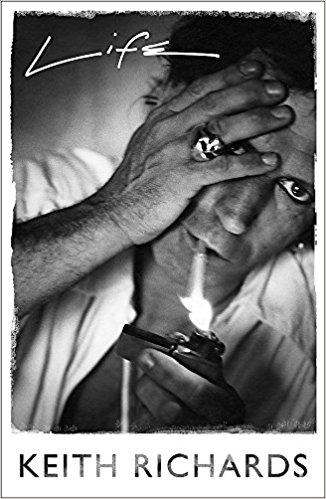
Keith Richards' 2010 autobiography: Life
Autobiography, Authenticity and Celebrity
“Life writers incorporate and reproduce models of identity in their narratives as ways to represent themselves to the reader.” (Smith & Watson 2010, 39)
Keith Richards is a rock ‘n roll superstar and he is so, apart from his musical achievements, by virtue of his (constructed) public image. Just like other celebrities, Richards has presented an image of himself that can be consumed by the public. Accordingly, there is a distance between the celebrity and his public: one produces, the other consumes.
Yet there is also a personal and more private element to celebrities. Their distance to the public invokes a longing for revelation in the audience; they want to get to know the real, authentic human being that lurks behind the presentation. As Marshall explains, “revelation of the private and the personal is the central narrative-like pattern of the ways in which celebrities are viewed by the public” (Marshall 2006, 502). Celebrities thus combine knowability with distance (Ingles 2010, 11). They are intensely familiar because they are consumed by individuals on a daily basis and in the most intimate of settings and moments, yet they are distant because of their supernatural status: they are humans after all but they are not humans like you and me.
The autobiography is the genre par excellence through which musical celebrities can enhance (or recover) their authenticity.
Celebrities have to tread this line thoughtfully because – especially in our modern age – the term celebrity has a somewhat negative connotation. It is has an air of inauthenticity to it: a celebrity is someone who constructs an image of himself that is not based on personality, but on market gains. Accordingly, celebrities have to be weary of the discrepancy between the ‘self’ (the personal and authentic) of the celebrity and the image of the celebrity (impersonal and fake) that can arise from this negotiation: “in its simultaneous embodiment of media construction, audience construction, and the real, living and breathing human being, the celebrity sign negotiates the competing and contradictory definitions of its own significance.” (Marshall 1997, XI). Give too much of your commodifed image and you are seen as fake; as nothing but a market toy. Give too much of your authentic self, to the point of violating the image you have always presented to your audience, and you are also seen as inauthentic: everything your audience believed was nothing but a commercial trick. It is therefore up to celebrities to give the public both: to give them a commodified image that the public knows and wants to consume, and to give them the authentic self that the public so desperately wants to uncover.
As previously mentioned, the danger is inauthenticity. This danger is particularly pertinent to musicians such as Keith Richards for, as Moore and Middleton explain, authenticity is “the validating criterion of musical value” and can be seen as the cultural capital that is fought over in the music industry" (Middleton 1990, 127). The reason for this is that authenticity is ascribed rather than inscribed: it is not an innate feature but a performative one (Moore 2002). The process of authentication is a matter of interpretation by the public and musicians influence this process in the hope of being granted this heuristic label.
The autobiography is the genre par excellence through which musical celebrities can enhance (or recover) their authenticity. This is because the term autobiography by itself already evokes the idea of authenticity and sincerity. As Philippe Lejeune has famously explained, author and reader enter a trust relationship through autobiography; they sign an (implied) autobiographical pact (Lejeune 1987). This pact assures the reader that “there is identity of name between the author (such as s/he figures, by name, on the cover), the narrator of the story and the character who is being talked about” (Lejeune 1987, 12). In other words, the author promises his readers that the subject of his story is the real and authentic self (i.e. that his story is rooted in authentic and personal experiences), and his readers – by believing this – promise to read his story as such.
The Stones were rebellious bohemians whose clothing, lifestyle and music reflected the challenge that was mounted by teenagers to the Establishment.
In addition, the autobiography allows the author to write about himself from both an externalized as well as an internal point of view. As the author is “both the observing subject and the object of investigation” (Smith & Watson 2010, 1), he confronts two versions of the self: the self that others see (the public persona, the image) and the self-experienced self (the authentic self). Writing an autobiography allows the celebrity to negotiate the two in order to avoid the previously discussed discrepancy between the public and the private self, and grants the celebrity full control over this negotiation.
The origins of Richards’ image(s)
Authenticity is very much a retrospective concept and often refers to the roots and origin of something or someone (Lindholm 2008). As such, in order to analyze the way in which Richards enhances his authenticity in Life, we must first have a better grasp of what the sources of his authenticity are. For that, we turn to the roots of Keith Richards’ image(s).
The two aspects of Keith Richards’ image that stand out, the rebellious and dangerous outlaw and the blues-loving musical purist, both find their origin in the early days of the Rolling Stones and especially in their opposition to the Beatles:
“The Beatles and the Stones were made into […] opposing poles […]: the good-boy mop tops versus the bad boy blues aficionados; the carefully groomed, non-confrontational Beatles versus the dangerous, long-haired Rolling Stones, and most importantly, the commercialized, fabricated Fab Four versus the authentic and real Stones.” (Millard 2013, 36)
“The Stones are more than a ‘pop’ group, forever desperately trying to make a hit, but enthusiasts for their own style of R’n’B”.
The Stones’ confrontational image was carefully fashioned by their manager Andrew Loog Oldham who marketed them as the ‘anti-Beatles’ (Millard 2013). In sharp contrast to the Beatles, who in those early days dressed and behaved like gentlemen, the Stones were rebellious bohemians whose clothing, lifestyle and music reflected the challenge that was mounted by teenagers to the Establishment. By creating savvy media headlines such as “Would you let your sister go with a Rolling Stone?” Oldham solidified the dichotomy between the Beatles and the Stones. Or, more aptly put, between the Establishment and the non-conformists (Staubmann 2013).
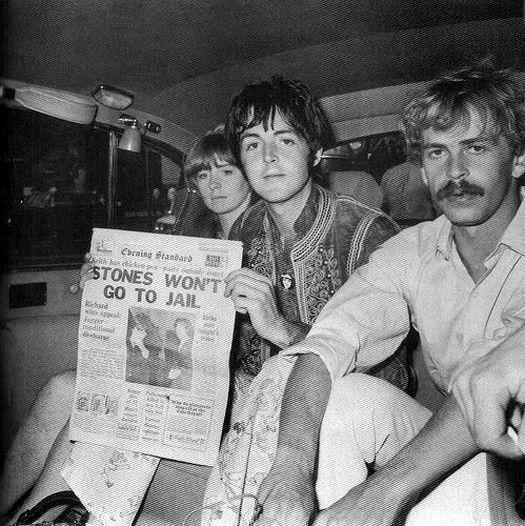
Paul McCartney holding up the latest news on the Stones in 1967
The tabloid press, with as their frontrunner News of the World, latched onto these media tactics and the Stones became the ‘most dangerous band in the world’ (Millard 2013). As a logical consequence, the Establishment responded by repudiating the Stones and in subsequent years, the Stones’ bad boy image manifested itself in various arrests for drug possession and drug abuse. When in 1967, the police raided Richards’ mansion Redlands and arrested both him and Jagger for drug possession, the Stones became outlaws in the public eye and especially Richards was targeted to play this role. Fueled by his increasing heroine use and arrests as a result of it, Richards became one of the primary images of the rebellious and dangerous youth culture that threatened Britain.
Still to this day, Richards is perceived as the rebellious and bohemian outlaw about whom various myths circulate: he has supposedly undergone treatment to have all his blood replaced in order to kick his drug addiction and in 2007 he reportedly snorted his father’s ashes. As we will see, Richards lives up to this aspect of his image throughout Life.
The second aspect of Richards’ image, also finds its roots in the purposefully inflated dichotomy between the Stones and the Beatles. Unlike the Beatles, whose polished and commercialized ‘pop’ sound seemed more attuned to attract a wider public, the Rolling Stones – a name taken from a Muddy Waters’ song – provided the public with a more rootsy and pure R&B style. As one commentator noted: “the Stones are more than a ‘pop’ group, forever desperately trying to make a hit, but enthusiasts for their own style of R’n’B” (Welch 1964 as cited in Cossu & Bortolini 2013, 24). This quote is exemplary of the way in which the roots of the Stones were emphasized in those early days (Staubmann 1997). Essential in this regard, and to Richards’ later image, is the fact that African American music was perceived by the public as being more pure and authentic than pop music:
“English audiences who had bought American blues, folk and R&B records felt that this music had a much older pedigree than pop music, which was perceived as manufactured and transitory. […] They believed that African American Music had an historic integrity and that it came from emotions and experiences held deeply and sincerely.” (Millard 2013, 47)
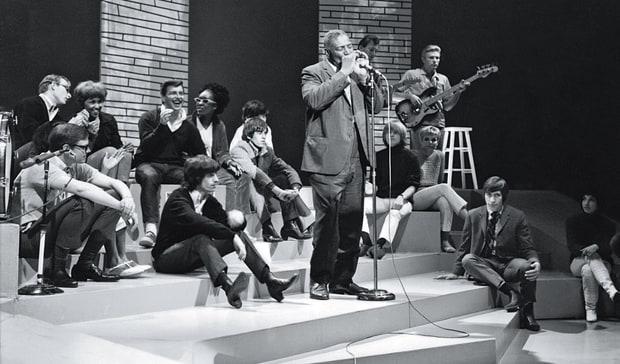
The Stones attending a performance by blues icon Howlin' Wolf in 1965 on the teen show 'Shindig!'
We can thus see that the Stones’ affiliation to Black American blues music enhanced their anti-commercial and l’art pour l’art image in those early days.
Richards recollecting his life is not just an act of personal remembering, but of collective remembering as well; the story of his life tells his readers something about their lives.
Unfortunately for them, the Stones have lost this image. As a result of their decreasing musical output, a string of bad reviews, and Jagger’s money-grabbing image, the Stones have become the template for running a band like an industry. Although Richards is undoubtedly liable in this regard he seems to have been able to evade these negative connotations. Throughout the years, Keith has been described as the essence of the ‘real’ Stones’ sound and as someone who, despite the financial gains, still tours ‘for the music’. As Mick Jagger noted in 1993: “rock writers perceive Keith to be this sort of living fount of the real thing” (Deevoy 1993 as cited in Cossu & Bartolini 2013). As we will see, this image of being a musical puritan forms a Leitmotiv throughout Richards’ autobiography.
The image(s) of Keith Richards: Life
Keith the rebellious outlaw
“Keith was a mess. But some folks, they just got a look in their eye, and he looked dangerous, and that’s the truth.” (Rolling Stones Saxophonist Bobby Keys in Richards & Fox 2010, 155)
Life tells the story of Richards’ life in chronological fashion and, as if it were a Künstlerroman, starts off with a discussion of his youth and how the seed of his rebellion was planted. Richards grew up in a middle-class household in Dartford as a shy choir boy and, apart from the occasional beatings, he did not have to struggle for much. That is, until he hit puberty. His voice broke, was kicked out of the school choir and after receiving a bad report, was forced to retake a year. These rather innocuous incidents are inflated in the early pages of Life and, recognizing the importance of such a thematic turning point, we can clearly see Fox’ hand in them:
“That report on science subjects contained the story of the big betrayal and of how I was turned from a reasonably compliant student into a school terrorist and a criminal, with a lively and lasting rage against authority.” (Richards & Fox 2010, 51-52)
Richards extensively describes this transition which is a transition that a great deal of his readers can identify with. Like many of his contemporaries, Richards changed his clothes, let his hair grow and put his chin up towards the authorities. In short, Richards became a rebel and this is an attitude that he has not lost since:
“It still rankles, that humiliation. It still hasn’t gone out, the fire. That’s when I started to look at the world in a different way, not their way anymore. That’s when I realized that there’s bigger bullies than just bullies. There’s them, the authorities. And a slow-burning fuse was lit.” (Richards & Fox 2010, 53)
The fact that Richards puts so much emphasis on this and the fact that illustrations of his non-conformist and dangerous attitude are scattered throughout the book cannot be seen as coincidences.
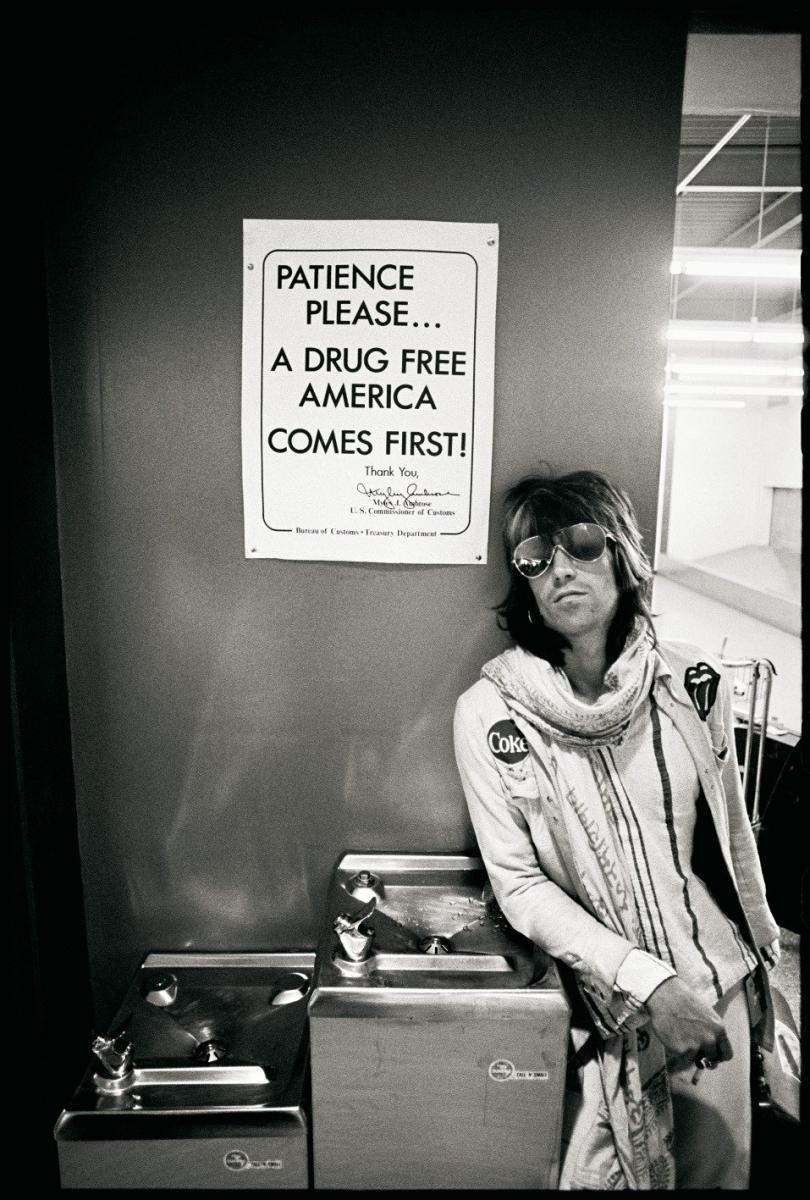
Richards arriving in the U.S. in 1972
One way in which Richards – but most probably Fox – does so, is by contextualizing his life. For example, when discussing the middle and late 60’s, Richards rather proudly cites a flyer that he found which read:
“The Bastards hear us playing you on you on our little transistor radios and know that they will not escape the blood and fire of the Anarchist Revolution. We will play your music, dear Rolling Stones, in rock and roll marching bands as we tear down the jails and free the prisoners and arm the poor. Tattoo Burn, Baby, Burn on the asses of the wardens and generals.” (Richards & Fox 2010, 251)
As was explained earlier, Richards garnered his reputation as a rebellious outlaw in the turbulent sixties and seventies. Crucially, this was a time during which counter-cultural and anarchistic sentiments were common among British youth. From a strategic point of view, it is important for Richards to identify with these sentiments because it is safe to assume that a great deal of his readers have lived through this period. Richards recollecting his life is therefore not just an act of personal remembering, but also of collective remembering: “memory is an intersubjective phenomenon, a practice not only for recollection of a past by a subject, but of recollection for another subject” (Mitchel 1994 as cited in Smith &Watson 2010, 26). Given the fact that Richards played an important role in many people’s lives and functioned as a role model, the story of his life tells his readers something about their lives. This might be the reason why Richards discusses this period extensively; in order to validate the image that many people have invested in and looked up to. In other words, he needs to show that his rebellious image finds its basis in a collectively experienced reality.
All of Richards' revelations add to his authenticity for they fit into the image that he has created for himself and that was created for him.
Although Richards never really shows where or when he personally made a contribution to a societal revolution (it actually becomes abundantly clear that he and the Stones were quite far removed from day-to-day society), this passage functions as a way to embed his story in collective history, and this takes place at several instances in Life. He for example invokes the Vietnam War – “you wouldn’t have had “Street Fighting Man” without the Vietnam War” – and makes ample reference to collectively experienced events in his life such as the trial following his 1967 drug bust in which he stated in response to the judge: “We are not old men. We are not worried about petty morals” (Richards & Fox 2010, 250, 226). This is Keith the rebel pur sang.
Apart from Richards’ discussion of music, the bulk of Life’s first four hundred pages is dedicated to boastful descriptions of his drug-infused lifestyle and his midnight escapades with fellow rock stars such as John Lennon:
“The thing was with John – for all his vaunted bravado – he couldn’t really keep up. He’d try and take anything I took but without my good training. A little bit of this, a little bit of that, couple of downers, a couple of uppers, coke and smack, and then I’m going to work. I was freewheeling. And John would inevitably end up in my john, hugging the porcelain.” (Richards & Fox 2010, 261-262)
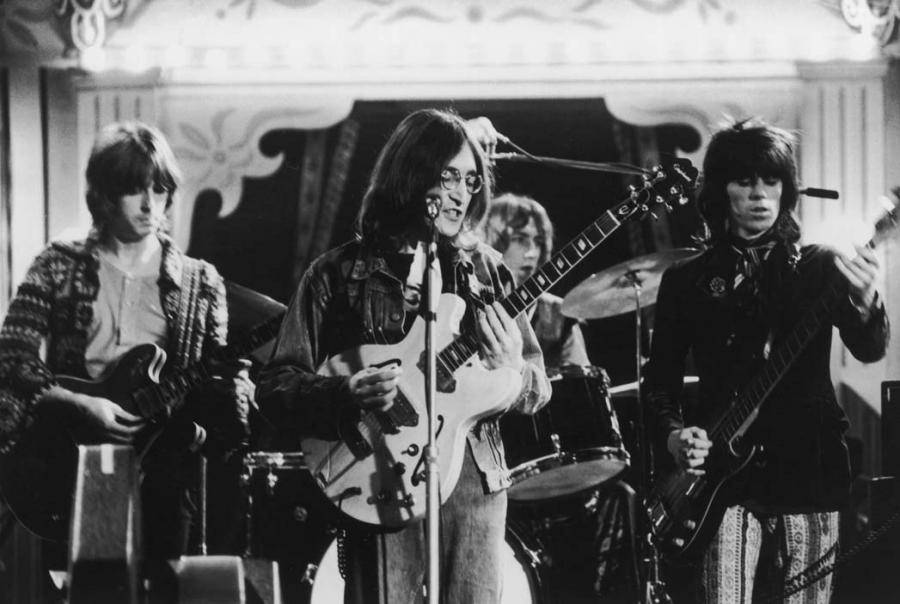
Richards performing alongside Eric Clapton and John Lennon for the recording of the Rolling Stones Rock and Roll Circus
His most prominent struggle in those days seemed to be the authorities who treated him like a criminal: “[the cops] come on heavy because they want to see if they can make a big rock-and-roll star quiver in his boots. […] What a mind-bending distraction” (Richards & Fox 2010, 286-287). This constant harassment made Richards “think like [a criminal]” and this might explain why he gives detailed descriptions of his relationship with weapons and why he shares various anecdotes about them throughout Life (Richards & Fox 2010, 287).
About guns: “quite a few of the guys we were travelling with were carrying shooters. They were fucking hard cats who I worked with” (Richards & Fox 2010, 162-163). About knives: “I’ve almost always carried a knife, and this one requires a special technique. […] The way it was explained to me, if you’re going to use a blade, the winner is the one who can make a quick horizontal cut across the other’s forehead” (Richards & Fox 2010, 345-346). And about threatening people with it, such as piano player Billy Preston for playing too loud: “I took him backstage and showed him the blade. “You know what this is, Bill? Dear William. If you don’t turn that fucking thing down right now, you’re going to feel it” (Richards & Fox 2010, 359).
Richards never really gets to the nitty-gritty of things, nor does he take responsibility.
The point here is that all these revelations add to Richards’ authenticity for they fit into the image that he has created for himself and that was created for him. These revelations strengthen his dangerous and rebellious image it and show how his image has a basis in reality. Although his revelations are private in nature, they aim to support the public self that the public knows. Richards thus gives his readers what they want and what they probably expected when they bought the book but because he bases this narrative in personal experiences, he also reveals something of himself.
Is there then nothing in Life that goes beyond Richards’ established image? Well, there are some unexpected revelations. For example when he discusses his relationship with women: “I have never put the make on a girl in my life. I just don’t know how to do it. My instincts are always to leave it to the woman. It’s the sir Galahad in me.” (Richards & Fox 2010, 214) Although this goes against the womanizing connotation that is attached to Richards’ rebellious image, it does not violate it. In fact, it adds depth, sophistication and self-consciousness to his character.
This self-consciousness is also shown when he discusses the people whom he, as an inevitable side-effect of his drug-crazed lifestyle, has hurt and neglected. It is here that Keith, but again probably Fox, is at his most careful. Whereas the passages about his midnight escapades and drug routines are candid in tone, the passages in which he reflects on his own misdoings have a more sober tone and are formulated much more precisely in order to make sure that he does not come across as a villain.
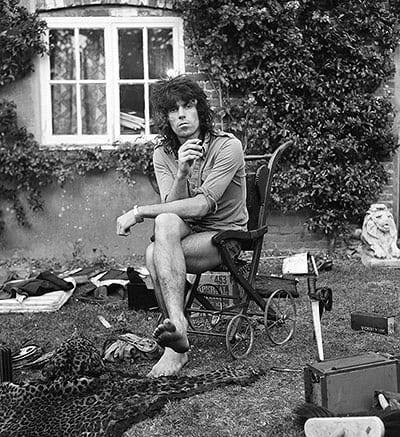
Richards smoking a cigarette in the garden of his Redlands home, 1973
Take for example the story about how Richards stole model Anita Pallenberg from bandmate Brian Jones. An incident that eventually drove the latter towards his death. The story is carefully spread out over several tens of pages with breaks in between and although Richards admits that both he and Jagger were “cruel” towards Brian, he never really gets to the nitty-gritty of things, nor does he take responsibility.
Another instance can be found when he discusses the way in which he has ignored his children. He even lets his son Marlon testify about the trauma’s he went through when he lived with his dad on the road. This is the only time that Richards invokes a source that does not unequivocally support him. Although Keith shows that he is aware of the damage he has done, he seems unwilling to take full responsibility:
“By now Marlon understands; it was the times, and the circumstances, that made it tough on him. It was very difficult to be one of the Rolling Stones and take care of your kids at the same time.” (Richards & Fox 2010, 447)
In most of these more fragile passages, Richards addresses the grievances that could possibly be mounted against him (by which he beats his readers to the punch), but he does not really get to the heart of them. Unlike other rock ‘n roll stars such as Eric Clapton, who laments his own misdoings throughout his autobiography and really grants his readers an insight into his mind, Richards deals with these issues in passing and grants them just the right amount of attention in order to come across as sophisticated and self-conscious, but not to the point where it violates and damages his image.
Keith the blues-loving musical purist
As was discussed earlier, the main criticism that has been mounted against the Rolling Stones since the 80’s is that they have leaned towards commercialism instead of staying true to their bluesy roots. Especially Jagger strayed far from his roots in the public eye, embracing a rock-as-business attitude instead. Richards on the other hand has retained the image of a drunken blues purist whose sole motivation in life is his love of music.
Although Richards is viewed as the torchbearer of the Stones’ authenticity, even he cannot deny the fact that he has been influenced by his status as a celebrity.
In Life, Richards is eager to self-fashion himself in this manner. Again like in a Künstlerroman, the protagonist finds his passion in his youth and explains how music functioned as a salvation for the (relative) hardships he endured: “it was very like a drug. In fact a far bigger drug than smack. I could kick smack; I couldn’t kick music” (Richards & Fox 2010, 57). In the subsequent pages, Richards describes how he learned to play acoustic guitar by himself and supports his statements by citing his diary entries and letters in which he expresses his fascination and thrill for the guitar. One of those letters also discusses the infamous moment in which he meets Mick Jagger and how the creative fuse between him and Jagger was ignited by their mutual love for real and pure blues music:
“Mick and I had a totally identical taste in music. We never needed to question or explain. It was all unsaid. We’d hear something, we’d both look at each other at once. Everything was to do with sound. We’d hear a record and go, that’s wrong. That’s faking. That’s real.” (Richards & Fox 2010, 84)
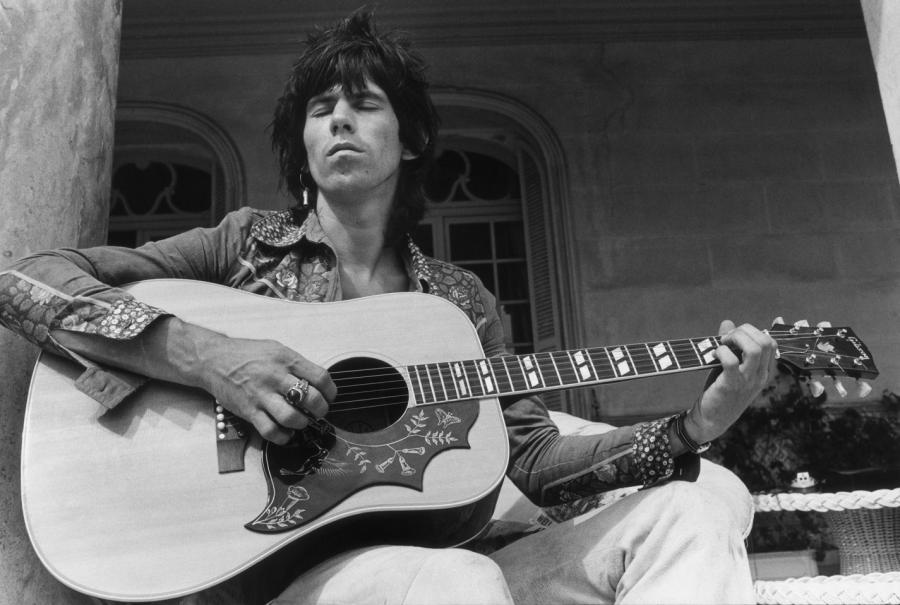
Richards in 1971, strumming his guitar on the steps of Villa Nellcôte in the South of France where the album Exile on Main Street was recorded.
In these early pages it becomes clear that Richards wants to solidify his l’art pour l’art attitude towards music as a Leitmotiv and the many pages dedicated to the process of songwriting, entitled “Keef’s Guitar Workshop”, serve to underscore this. He also emphasizes that commercialism was not on his mind in those days. As he explains: “we didn’t want to make money. We despised money, we despised cleanliness, we just wanted to be black motherfuckers” (Richards & Fox 2010, 104). After all, his greatest inspiration came from African American guitarists and homages to blues legends such as Muddy Waters, Howlin’ Wolf, Robert Johnson and rock ‘n roll pioneer Chuck Berry pop up throughout Life. He also explains how, as an unintended side-effect of their love for music, the Stones made black music acceptable:
“The most bizarre part of the whole story is that having done what we intended to do in our narrow, purist brain at the time, which was to turn people on to the blues, what actually happened was we turned American people back on to their own music. And that is probably our greatest contribution to music. We turned white America’s brain and ears around.” (Richards & Fox 2010, 159)
“Mick picked up the slack; I picked up the smack”
Even though the intent at that time was to turn people on to the blues, commercialism took over quickly and Richards emphasizes that the fame that accompanied it never sat easily with him: “It’s not that easy being famous; you don’t want to be. But at the same time you’ve got to be in order to do what you’re doing” (Richards & Fox 2010, 146).
The issue of the Stones’ perceived inauthenticity grows as Life approaches the present. Although Richards is viewed as the torchbearer of the Stones’ authenticity, even he cannot deny the fact that he has been influenced by his status as a celebrity, and that he has played into the role that was created for him. Recognizing this issue as the hot potato it is, he addresses it head on:
“I can’t untie the threads of how much I played up to the part that was written for me. I mean the skull ring and the broken tooth and the kohl. Is it half and half? I think in a way your persona, your image, as it used to be known, is like a ball and a chain. […] I think some of it is that there is so much pressure to be that person that you become it, maybe, to a certain point that you can bear.” (Richards & Fox 2010, 364)
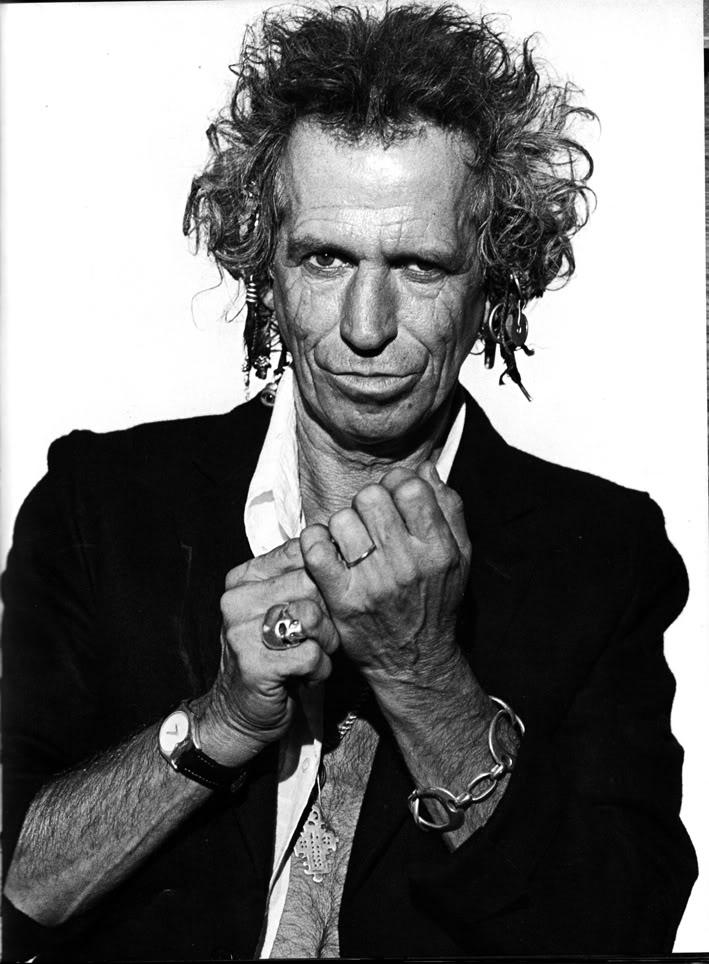
Richards showing off his skull ring in 1999
These strategically placed passages of self-reflection return at various stages in Life and serve to show that he is aware of his status as a celebrity and that therefore, also he has constructed an image of himself that is not primarily based on personality, but on market gains. His confession serves to blur the distinction between his public and personal self, by which he downplays the discrepancy between the two. As such, although the act of playing into his image might make him insincere and inauthentic, the fact that he knows it diminishes the severity of these grievances, making him an authentic and sincere individual after all.
“I’m not here just to make records and money. I’m here to say something and to touch other people”
This in sharp contrast to Mick Jagger who, nearing the end of Life and especially in chapter 12, is chided for being an insatiable control freak who was (and at times still is) more obsessed with his image and solo projects than the artistic future of the Rolling Stones: “Mick had fallen in love with power while I was being…artistic” (Richards & Fox 2010, 432). Although I never noticed this during my previous readings of Life, I recently realized that the entire book in fact works towards, what Richards calls, ‘World War III’ and that Richards alludes to Mick’s transformation at various points in the book: “Mick has changed tremendously”, “Mick’s always looking to separate himself from the band”, and “Mick picked up the slack; I picked up the smack” (Richards & Fox 2010, 126, 295, 338).
Richards’ stabs towards Jagger became the main focus of the press upon publication and especially Richards’ insinuations about the disappointing size of Jagger’s ‘todger’ were easily sensationalized. We can thus say that it was a smart marketing trick to sell more copies of Life. Yet apart from his cheeky allusions, the heart of Richards point (and he has been making it ever since the 80’s) seems to revolve around the authenticity of the Stones. According to him, Jagger has undermined the authenticity of the Stones by starting an unsuccessful solo project and calling the Stones a millstone around his neck (Richards & Fox 2010, 464):
“The Rolling Stones spent a lot of time building up integrity, as much as you can get in the music industry. And the way Mick handled his solo career [going on a world tour playing Rolling Stones songs without the Rolling Stones] jeopardized all that, and it severely pissed me off” (Richards & Fox 2010, 471-472).
The fact that Jagger accepted a knighthood in 2003 by which “he’d blown his credibility”, made matters even worse: “it’s a demeaning thing to do. It’s called the honors list but we’ve been honored enough. The public has honored us. You’re going to accept an honor from a system that tried to put you in jail for nothing?” (Richards & Fox 2010, 535). In these pages, Richards firmly juxtaposes himself with Jagger and by doing so enhances his image of the authentic musical purist: “I’m not here just to make records and money. I’m here to say something and to touch other people” (Richards & Fox 2010, 546).
Believing in Richards' authenticity
“Reading “Life” is like getting to corner Keith Richards in a room and ask him everything you ever wanted to know about the Rolling Stones, and have him be completely honest with you.” (Phair 2010, n.p.)
If you would have asked me five years ago, I would have wholeheartedly agreed with this. But now that I have subjected Life to critical scrutiny, I am not so sure whether I have gotten to ‘know’ Keith Richards. Life is too smooth for that and, as I have explained, is too hesitant to go off the track that has been beaten by his image. There is simply too much at stake for him.
The general reader is most probably unfettered by this and Life has successfully preserved the authenticity Richards already enjoyed. Yet we could even say that the value of Life stretches beyond him as an individual. For Richards’ authenticity plays a crucial role in preserving the authenticity of the Rolling Stones:
“As the authorized speaker and promoter of the Stones’ authenticity, Keith Richards has often worked as an agent who has played a double role; he has acted, often publicly as the agent able to legitimize the band’s claims to authenticity, but he has also been a promoter of a normative discourse about the reasons why the Stones had to remain authentic, which in his vision has often meant staying true to the roots that were defined at the beginning of the band’s trajectory.” (Cossu & Bartolini 2013)
As such, and in spite of knowing better: if me believing in Richards’ (constructed) authenticity means that the band I love stays true to their roots and retains their musical value, even if it is only for a little longer, I am happy to oblige.
References
Cossu, H & Bortolini, M. The Spider and the Fly. Authenticity and the Rolling Stones. 21-34.
Lejeune, P. (1987). On Autobiography. Minneapolis: University of Minnesota Press.
Lindholm, C. (2008). Culture and Authenticity. Malden, MA: Blackwell Publishing.
Marshall, P.D. (1997). Celebrity and Power. Fame in Contemporary Culture. Minneapolis/London: University of Minnesota Press.
Marshall, P.D. (Ed.). (2006). The Celebrity Culture Reader. New York: Routledge.
Marshall, P.D. The Celebrity Legacy of the Beatles. 501-510
Middleton, R. (1990). Studying Popular Music. Milton Keynes England: Open University Press.
Millard, A. The Anti-Beatles. The Beatles versus the Stones Debate during the “British Invasion”. 36-52.
Moore, A. (2002). Authenticity as authentication. Popular Music, 21(2), doi:10.1017/S0261143002002131.
Phair, L. (2010, November 4). Stray Cat Blues. Retrieved February 19, 2018.
Richards, K. & Fox J. (2010) Life. London: Weidenfeld & Nicolson.
Smith, S., & Watson, J. (2010). Reading Autobiography: A Guide for Interpreting Life Narratives. (2nd ed.). Minneapolis: University of Minnesota Press.
Staubmann, H. (Ed.). (2013). The Rolling Stones: Sociological Perspectives.
Staubmann, H. Introduction. The Rolling Stones in Sociological Perspectives. 6-19.